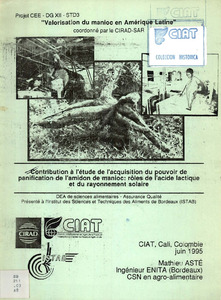Contribution à l`étude de l`acquisition du pouvoir de panification de l`amidon de manioc: rôles de l`acide lactique et du rayonnement solaire
Fermented and sun-dried cassava starch posesses bread-making properties that are exploited in the making of various traditional foodstuffs in Latin America. A kinetic fermentation study and the washing of different sour cassava starch samples enabled the study of the specific effect of fermentation and lactic acid on the acquisiton of bread-making capacity. Solar radiation filters (transmitance more than 60 percent for indicated wavelengths: 280, 340, 390 and 640 nm) were used to determine the wavelengths most effective for the acquisiton of breadmaking capacity, and to study the effect of different wavelengths on rheological properties. Cassava fermentation leads to a large drop in pH, and icnreases in total acidity and lactic acid content. Viscosity values at 88 degress C and retrogradation tendence decrease in relation to fermentation period length. Impregnation with lactic acid of briefly fermented cassava starch led to an improvement in breadmaking capacity, althought the performance of long-fermented sour starch wa not attained. Hence, fermentation, as well as producing lactic acid, also has an effect regarding breadmaking capacity. Solar drying is also required for the acquisition of breadmaking capacity: it appears to further develop starch previously transformed during fermentation. Solar radiations of 340 to 640 nm were found to be most effective in inducing breadmaking capacity in starches dried under the prevailling conditions of the CIAT (Palmira, Colombia).

